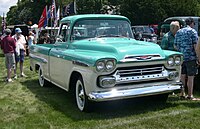Chevrolet Task Force
The Chevrolet Task Force was Chevrolet's successor to the Advance Design series. The Task Force Series ran from late 1955 (second series) through 1959. At GMC dealers, it was called the Blue Chip Series.
The 1955 second series offered standard options and add-ons such as 12-volt electrical systems, Chevrolet’s first V8 engine since the 1917 288 cu in (4.7 L) Chevrolet Series D, and Fleetside beds in 1958. Commercial trucks and various other heavy duty models were available.[1]
Differences
1955 Second Series or Stepside Series: First year for new body style. New "wrap-around" windshield—a truck industry first[2]—and optional wrap-around rear window on Deluxe cabs.[3] Power steering and power brakes became available for the first time on GM trucks. Electrical system upgraded to 12 volts. Beds are 6.5 ft (2.0 m) and 7.5 ft (2.3 m). Fenders have single headlights and one-piece emblem is mounted below horizontal line on fender.[4] The more luxurious Cameo Carrier series introduced; GMC's version was called the "Suburban."
1956: Wider hood emblem. Two-piece fender emblems are mounted above horizontal fender line. Last year for eggcrate grille.
1957: Only year for more open grille. Hood is flatter with two spears on top, similar to the 1957 Bel Air. Fender emblems are still above fender line, but are now oval-shaped, as opposed to previous versions in script.
1958: First year for new Fleetside bed (called Wideside by GMC) in 6.5 ft (2.0 m) and 8 ft (2.4 m) lengths, significant redesign of front end. All light-duty trucks are now called "Apache", medium-duty trucks called "Viking", and heavy-duty trucks called "Spartan". Truck has four headlights instead of the previous two and features a shorter, wider grille running the width of the front end. Parking lights are now in the grille instead of being in the front of the fender and the hood is similar to 1955/1956 models, but with a flat "valley" in the middle. First year for factory-equipped air conditioning. For 1958, GM was promoting their fiftieth year of production, and introduced Anniversary models for each brand; Cadillac, Buick, Oldsmobile, Pontiac, and Chevrolet.[5] The trucks also received similar attention to appearance, while staying essentially durable, with minimal adornment.
1959: Minimal changes from 1958, the most apparent was a larger and more ornate hood emblem and redesigned badging on the fenders. This was the last year that the NAPCO (Northwestern Auto Parts Company) "Powr-Pak" four-wheel drive conversion could be factory ordered.
1960: The Chevrolet and GMC C/K-Series replaced the line.
-
1955 Chevrolet Task Force
-
1955 GMC Blue Chip 150
-
1956 Chevrolet 3100
-
1956 GMC Blue Chip
-
1957 Chevrolet Task Force 4WD
-
1957 GMC Suburban Carrier
-
1958 Chevrolet Apache 4WD (NAPCO)
-
1958 GMC Suburban
-
1959 Chevrolet Apache
-
1959 GMC 9310 pickup truck
References
- ^ "1955 Chevrolet truck brochure" (PDF). GM heritage center. 1955. Retrieved April 16, 2020.
- ^ Bunn, Don. "Segment Five: 1955-1959 Early V8 Pickups", Pickuptruck.com. Archived 2019-01-12 at the Wayback Machine Retrieved on July 2, 2008.
- ^ "LMC Truck Catalog", Winter 2007/2008
- ^ "What Year is My Truck?", Classicparts.com. Retrieved on July 2, 2008.
- ^ Image of 50th Anniversary promotional photo Archived 2015-10-17 at the Wayback Machine











